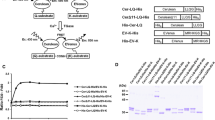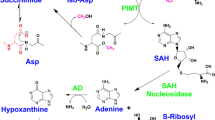Abstract
Transglutaminases (TGs) are a protein family that catalyzes isopeptide bond formation between glutamine and lysine residues of various proteins. There are eight TG isozymes in humans, and each is involved in diverse biological phenomena due to their characteristic distribution. Abnormal activity of TG1 and TG2, which are major TG isozymes, is believed to cause various diseases, such as ichthyosis and celiac disease. To elucidate TGs’ mechanisms of action and develop new therapeutic strategies, it is essential to develop bioprobes that can specifically examine the activity of each TG isozyme, which has not been sufficiently studied. We previously have identified several substrate peptide sequences containing Gln residues for each isozyme and developed a method to detect isozyme-specific activities by incorporating a labeled substrate peptide into lysine residues of proteins. We prepared the fluorescein isothiocyanate (FITC)-labeled Gln substrate peptide (FITC-K5 and FITC-T26) and Rhodamine B-labeled Lys substrate peptide (RhoB-Kpep). Each TG reaction specifically cross-linked these probe pairs, and the proximity of FITC and Rhodamine B significantly decreased the fluorescence intensity of FITC depending on the concentration and reaction time of each TG. In this study, we developed a peptide-based biosensor that quickly and easily measures TG isozyme-specific activity. This probe is expected to be helpful in elucidating TG’s physiological and pathological functions and in developing compounds that modulate TG activity.






Similar content being viewed by others
Data availability
All data generated or analyzed in this study are available from the corresponding author upon reasonable request.
Abbreviations
- FRET:
-
Förster resonance energy transfer
- FITC:
-
Fluorescein isothiocyanate
- PBS:
-
Phosphate buffered saline
- RhoB:
-
Rhodamine B
- TG:
-
Transglutaminase
References
Acikgoz S, Aktas G, Inci MN et al (2010) FRET between BODIPY azide dye clusters within PEG-based hydrogel: a handle to measure stimuli responsiveness. J Phys Chem B 114:10954–10960. https://doi.org/10.1021/JP101663B
Caron NS, Munsie LN, Keillor JW, Truant R (2012) Using FLIM-FRET to measure conformational changes of transglutaminase type 2 in live cells. PLoS One. https://doi.org/10.1371/journal.pone.0044159
Doose S, Neuweiler H, Sauer M (2005) A close look at fluorescence quenching of organic dyes by tryptophan. ChemPhysChem 6:2277–2285. https://doi.org/10.1002/CPHC.200500191
Eckert RL, Kaartinen MT, Nurminskaya M et al (2014) Transglutaminase regulation of cell function. Physiol Rev 94:383–417. https://doi.org/10.1152/physrev.00019.2013
Fleckenstein B, Molberg Ø, Qiao S-W et al (2002) Gliadin T cell epitope selection by tissue transglutaminase in celiac disease. Role of enzyme specificity and pH influence on the transamidation versus deamidation reactions. J Biol Chem. https://doi.org/10.1074/jbc.M204521200
Folk JE, Park MH, Chung SI et al (1980) Polyamines as physiological substrates for transglutaminases. J Biol Chem 255:3695–3700. https://doi.org/10.1016/S0021-9258(19)85760-5
Hitomi K, Kitamura M, Alea MP et al (2009a) A specific colorimetric assay for measuring transglutaminase 1 and factor XIII activities. Anal Biochem 394:281–283. https://doi.org/10.1016/J.AB.2009.07.039
Hitomi K, Kitamura M, Sugimura Y (2009b) Preferred substrate sequences for transglutaminase 2: screening using a phage-displayed peptide library. Amino Acids 36:619–624. https://doi.org/10.1007/s00726-008-0126-6
Hitomi K, Kojima S, Fésüs L (eds) (2015) 1st edn. Springer, Tokyo
Huber M, Rettler I, Bernasconi K et al (1995) Mutations of keratinocyte transglutaminase in lamellar ichthyosis. Science 267:525–528. https://doi.org/10.1126/SCIENCE.7824952
Iismaa SE, Mearns BM, Lorand L, Graham RM (2009) Transglutaminases and disease: lessons from genetically engineered mouse models and inherited disorders. Physiol Rev 89:991–1023. https://doi.org/10.1152/physrev.00044.2008
Itoh M, Kawamoto T, Tatsukawa H et al (2011) In situ detection of active transglutaminases for keratinocyte type (TGase 1) and tissue type (TGase 2) using fluorescence-labeled highly reactive substrate peptides. J Histochem Cytochem 59:180–187. https://doi.org/10.1369/jhc.2010.957225
Itoh M, Tatsukawa H, Eun-Seo L et al (2013) Variations in both TG1 and TG2 isozyme-specific in situ activities and protein expressions during mouse embryonic development. J Histochem Cytochem 61:793–801. https://doi.org/10.1369/0022155413501676
Jeitner TM, Pinto JT, Krasnikov BF et al (2009) Transglutaminases and neurodegeneration. J Neurochem 109:160–166. https://doi.org/10.1111/j.1471-4159.2009.05843.x
Lebwohl B, Sanders DS, Green PHR (2018) Coeliac disease. Lancet (london, England) 391:70–81. https://doi.org/10.1016/S0140-6736(17)31796-8
Lorand L, Graham RM (2003) Transglutaminases: crosslinking enzymes with pleiotropic functions. Nat Rev Mol Cell Biol 4:140–156. https://doi.org/10.1038/nrm1014
Mehta K, Kumar A, Kim HI (2010) Transglutaminase 2: a multi-tasking protein in the complex circuitry of inflammation and cancer. Biochem Pharmacol 80:1921–1929. https://doi.org/10.1016/J.BCP.2010.06.029
Pavlyukov MS, Antipova NV, Balashova MV, Shakhparonov MI (2012) Detection of transglutaminase 2 conformational changes in living cell. Biochem Biophys Res Commun 421:773–779. https://doi.org/10.1016/j.bbrc.2012.04.082
Perez Alea M, Kitamura M, Martin G et al (2009) Development of an isoenzyme-specific colorimetric assay for tissue transglutaminase 2 cross-linking activity. Anal Biochem 389:150–156. https://doi.org/10.1016/J.AB.2009.03.029
Russell LJ, Digiovanna JJ, Rogers GR et al (1995) Mutations in the gene for transglutaminase 1 in autosomal recessive lamellar ichthyosis. Nat Genet 9:279–283. https://doi.org/10.1038/NG0395-279
Siegel M, Khosla C (2007) Transglutaminase 2 inhibitors and their therapeutic role in disease states. Pharmacol Ther 115:232–245. https://doi.org/10.1016/j.pharmthera.2007.05.003
Sivadó É, El Alaoui M, Kiraly R et al (2019) Optimised methods (SDS/PAGE and LC-MS) reveal deamidation in all examined transglutaminase-mediated reactions. FEBS Open Bio 9:396–404. https://doi.org/10.1002/2211-5463.12575
Sollid LM, Jabri B (2011) Celiac disease and transglutaminase 2: a model for posttranslational modification of antigens and HLA association in the pathogenesis of autoimmune disorders. Curr Opin Immunol 23:732–738. https://doi.org/10.1016/J.COI.2011.08.006
Sugimura Y, Hosono M, Wada F et al (2006) Screening for the preferred substrate sequence of transglutaminase using a phage-displayed peptide library: identification of peptide substrates for TGASE 2 and Factor XIIIA. J Biol Chem 281:17699–17706. https://doi.org/10.1074/jbc.M513538200
Sugimura Y, Hosono M, Kitamura M et al (2008) Identification of preferred substrate sequences for transglutaminase 1—development of a novel peptide that can efficiently detect cross-linking enzyme activity in the skin. FEBS J 275:5667–5677. https://doi.org/10.1111/j.1742-4658.2008.06692.x
Takeuchi T, Tatsukawa H, Shinoda Y et al (2021) Spatially resolved identification of transglutaminase substrates by proteomics in pulmonary fibrosis. Am J Respir Cell Mol Biol 65:319–330. https://doi.org/10.1165/RCMB.2021-0012OC/SUPPL_FILE/DISCLOSURES.PDF
Tatsukawa H, Abe N, Ohashi S, Hitomi K (2015) Distribution of transglutaminase family members in mouse whole body sections. Biochem Biophys Res Commun 467:1046–1051. https://doi.org/10.1016/j.bbrc.2015.10.001
Tatsukawa H, Furutani Y, Hitomi K, Kojima S (2016) Transglutaminase 2 has opposing roles in the regulation of cellular functions as well as cell growth and death. Cell Death Dis 7:e2244. https://doi.org/10.1038/cddis.2016.150
Tatsukawa H, Liu HH, Oba S et al (2017a) FRET-based detection of isozyme-specific activities of transglutaminases. Amino Acids 49:615–623. https://doi.org/10.1007/s00726-016-2322-0
Tatsukawa H, Tani Y, Otsu R et al (2017b) Global identification and analysis of isozyme-specific possible substrates crosslinked by transglutaminases using substrate peptides in mouse liver fibrosis. Sci Rep 7:45049. https://doi.org/10.1038/srep45049
Tatsukawa H, Otsu R, Tani Y et al (2018) Isozyme-specific comprehensive characterization of transglutaminase-crosslinked substrates in kidney fibrosis. Sci Rep 8:7306. https://doi.org/10.1038/s41598-018-25674-4
Tatsukawa H, Hitomi K, Edwards V et al (2021) Role of transglutaminase 2 in cell death, survival, and fibrosis. Cells 10:1842. https://doi.org/10.3390/CELLS10071842
Tripathy D, Migazzi A, Costa F et al (2020) Increased transcription of transglutaminase 1 mediates neuronal death in in vitro models of neuronal stress and Aβ1–42-mediated toxicity. Neurobiol Dis 140:104849. https://doi.org/10.1016/J.NBD.2020.104849
Vaiana AC, Neuweiler H, Schulz A et al (2003) Fluorescence quenching of dyes by tryptophan: interactions at atomic detail from combination of experiment and computer simulation. J Am Chem Soc 125:14564–14572. https://doi.org/10.1021/JA036082J
Watanabe K, Tsunoda K, Itoh M et al (2013) Transglutaminase 2 and Factor XIII catalyze distinct substrates in differentiating osteoblastic cell line: utility of highly reactive substrate peptides. Amino Acids 44:209–214. https://doi.org/10.1007/s00726-011-1131-8
Acknowledgements
This work was supported by Grant-in-Aid for Scientific Research (26292192 and 18H02134 awarded to K.H. and 19K08675 awarded to H. Tatsukawa) from the Ministry of Education, Sports, Science and Technology (JSPS, KAKENHI, Japan) and by grants from the Japan Foundation for Applied Enzymology, Nagoya University—Amano Enzyme Research Grant, Aichi Kidney Foundation, Tatematsu Foundation, Takeda Science Foundation, and Terumo Life Science Foundation. Authors are gratefully thankful to the CARE (The Center for Animal Research and Education) at Nagoya University for technical supports for animal experiments.
Author information
Authors and Affiliations
Contributions
HT designed the study and drafted the manuscript. RA performed the development and characterization of biosensor probes. KH helped to design the study and provided the technical and material supports. All authors have read and approved the final manuscript.
Corresponding author
Ethics declarations
Competing interests
The authors declare no competing interests.
Conflict of interest
The authors declare that they have no conflict of interests.
Human and animal rights statement
Animal experiments were conducted at Nagoya University and complied with the national guidelines for the care and use of laboratory animals.
Additional information
Handling editor: F. Polticelli.
Publisher's Note
Springer Nature remains neutral with regard to jurisdictional claims in published maps and institutional affiliations.
Supplementary Information
Below is the link to the electronic supplementary material.
726_2023_3272_MOESM1_ESM.tif
Supplementary Figure 1. Emission spectrums when FITC was excited in the developed biosensors. Schematic diagram of the FRET probe detecting TG activity. Cross-linking of reactive TG substrate peptides, including Gln or Lys, closes the distance between FITC and RhoB fluorescent molecules, leading to the decrease of FITC emission intensity (red arrow) and the increase of RhoB emission intensity (blue arrow) (A). FITC-K5/RhoB-Kpep and FITC-T26/RhoB-Kpep were incubated with TG1 and TG2, respectively, and the emission spectrums of 500–600 nm, when the FITC was excited at 480 nm, were measured at each indicated time (B and C) (TIF 919 KB)
726_2023_3272_MOESM2_ESM.tif
Supplementary Figure 2. Emission spectrums when RhoB was excited in the biosensors. FITC-K5/RhoB-Kpep and FITC-T26/RhoB-Kpep were incubated with TG1 and TG2, respectively. The emission spectrums of 575–635 nm, when the RhoB was excited at 555 nm, were measured at each indicated time (A and B) (TIF 772 KB)
726_2023_3272_MOESM3_ESM.tif
Supplementary Figure 3. Mass spectrometry analyses in the biosensors. FITC-K5/RhoB-Kpep and FITC-T26/RhoB-Kpep were incubated with TG1 and TG2, respectively. These samples were dissolved with 5% acetonitrile/0.1% formic acid and desalted using GL-tip SDB (GL Sciences Inc.). Mass spectrometry was performed on a Q Exactive mass spectrometer (Thermo Fisher Scientific) and the spectrums in FITC-K5/RhoB-Kpep (A) and FITC-T26/RhoB-Kpep (B and C) were indicated after peak deconvolution using the Xtract algorithm within FreeStyle software (Themo Fisher Scientific). Cal. Mass, Calculated Mass (TIF 717 KB)
726_2023_3272_MOESM4_ESM.tif
Supplementary Figure 4. Dose response to TG inhibitor treatments in the biosensor. FITC-T26/RhoB-Kpep was incubated with TG2 in the presence or absence of each TG inhibitor, Z-DON (A), Boc-DON (B), and cystamine (C) at the indicated dose. The emission intensities of FITC were measured at each indicated time (TIF 1096 KB)
Rights and permissions
Springer Nature or its licensor (e.g. a society or other partner) holds exclusive rights to this article under a publishing agreement with the author(s) or other rightsholder(s); author self-archiving of the accepted manuscript version of this article is solely governed by the terms of such publishing agreement and applicable law.
About this article
Cite this article
Tatsukawa, H., Aoyama, R. & Hitomi, K. Development of peptide-based biosensors for detecting cross-linking and deamidation activities of transglutaminases. Amino Acids 55, 807–819 (2023). https://doi.org/10.1007/s00726-023-03272-7
Received:
Accepted:
Published:
Issue Date:
DOI: https://doi.org/10.1007/s00726-023-03272-7




